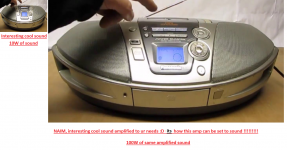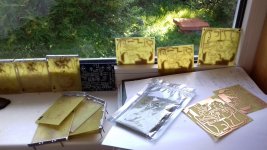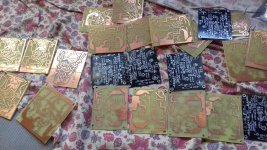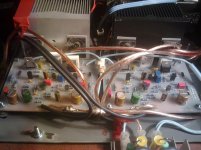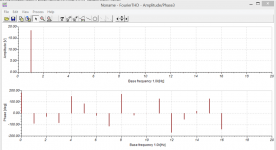The Naim is an odd design that has some oscillation modes that are fairly benignly (ie: without setting anything on fire). It may be this benign oscillation that's causing fatigue....
Yes, sometimes i get a feeling that LEFT and RIGHT channels are heavily dependent on each other... its like they watch over themselfs all day long lol...
You just dont belive how cool and different ways it can be set to sound.
I know lots of ppl like to feel BASS WITH UR BODY...
THIS AMP gives and opportunity to feel not only bass but all the middle stuff with ur body without fatigue...
ITS LIKE, have u ever listened to a panasonic soundbox that u liked at its time ? Naim is a topology that can be made to sound the same but with alot more balls
EDIT: It is so strange, even if one channel output bias is off by 1mA, it can be detected acoustically. These delays, anomalies can be used to your liking... the problem is that there are 1 million ways to get it wrong
Attachments
Last edited:
I would have a look at the HF performance with a decent oscilloscope if you ever experience listening fatigue. You may be either straining to listen too hard and long or there really are visible signs of instability or maybe just harmonic distortion. Assuming you can do this testing at your workplace, perhaps they also have a low distortion oscillator that can be your 1 kHz pure reference tone.
Last edited:
Yep, but i think i will have to solder new boards...i have thousands of them, various designs.
Its not the oscillation that causes fatigue imo...i haven't listened to a direct oscillating amplifier yet... and i don't know how it should sound.. i expect it to distord heavily so a even a child can detect it from speakers.
But fatigue is a thing where LEFT and RIGHT channels dont get "along" with each other
Its like listening to a woman always screaming at you... to avoid fatigue... i go away Or i will shut the amplifier down...
Or i will shut the amplifier down... 
listening fatigue
Its not the oscillation that causes fatigue imo...i haven't listened to a direct oscillating amplifier yet... and i don't know how it should sound.. i expect it to distord heavily so a even a child can detect it from speakers.
But fatigue is a thing where LEFT and RIGHT channels dont get "along" with each other
Its like listening to a woman always screaming at you... to avoid fatigue... i go away
An amplifier that is truly working properly does not wear you down and make you want to stop listening. The opposite. A particular recording might, especially if badly mastered or from the early digital era for instance. But not the amplifier.
I'm listening to Coldplay's Yellow. It has a full range of frequencies and mellow bass lines and very snappy drums and guitar plucks, all coexisting in the same space yet completely separated; instruments having their own textures and vibrancy and presence, and sharing timing together. Separate but together. I just want to turn it up; but I'm not alone in my house. It is the opposite of fatiguing; it's engaging, invigorating and sort of makes me feel I'm inside the music in a 3D way. I'm part of it. There are no sounds that are out of place, wrongly located, wrongly prominent, edgy nor synthetically constrained, no irritating synthetic signature constantly trying to dispel the magic.
It may be this glass of blueberry wine, but I'm pretty sure I'll feel the same way in the morning.
I'm listening to Coldplay's Yellow. It has a full range of frequencies and mellow bass lines and very snappy drums and guitar plucks, all coexisting in the same space yet completely separated; instruments having their own textures and vibrancy and presence, and sharing timing together. Separate but together. I just want to turn it up; but I'm not alone in my house. It is the opposite of fatiguing; it's engaging, invigorating and sort of makes me feel I'm inside the music in a 3D way. I'm part of it. There are no sounds that are out of place, wrongly located, wrongly prominent, edgy nor synthetically constrained, no irritating synthetic signature constantly trying to dispel the magic.
It may be this glass of blueberry wine, but I'm pretty sure I'll feel the same way in the morning.
You've described non-fatiguing listening but not the likely reasons. I think I know what you mean about amplifiers working properly but I usually interpret mellow bass, snappy drums, vibrancy, presence and coordination as aspects of good musicianship and recording production technique rather than good quality amplification. Certainly, Vereker used similar imagery to describe and promote "Naim sound" but I doubt that many audio design professionals would have expressed agreement or admitted to knowing what he was on about.
Now this is what i am all about  ) and always have been. I expect nothing more.
) and always have been. I expect nothing more.
I just cant listen to other amps... they are TOOOO BOORING... some are pleasant, some are soft but still too booooring omg...
Naim is the thing for me.
Yes, the immune system and all association with it must be also taken into account... This is the area where we perceive sounds differently.
Alcohol and peppermint tea gives the biggest influence on your perception for sound...., last one is what i prefer
For example, an amp can sound better even if u work out constantly at nights or whatever.
I just cant listen to other amps... they are TOOOO BOORING... some are pleasant, some are soft but still too booooring omg...
Naim is the thing for me.
It may be this glass of blueberry wine, but I'm pretty sure I'll feel the same way in the morning.
Yes, the immune system and all association with it must be also taken into account... This is the area where we perceive sounds differently.
Alcohol and peppermint tea gives the biggest influence on your perception for sound...., last one is what i prefer
For example, an amp can sound better even if u work out constantly at nights or whatever.
Last edited:
Yes. I see each stage in the recording/reproducing chain corrupting the music. The potential excellence of the musicians gets tarnished along the way, usually a big dollop happens downstream of the CD/wav, in the home. But I do have some music that has clearly been mangled upstream. Obviously, the better the home system the more distinctly you can hear the studio affects.I think I know what you mean about amplifiers working properly but I usually interpret mellow bass, snappy drums, vibrancy, presence and coordination as aspects of good musicianship and recording production technique rather than good quality amplification.
I should point out that I am not listening to a Naim amp. Ever since I got exposed to high end gear at uni., I have been curious about the divisive response to Naim. Naim seemed to evoke a Marmite reaction. I was impressed by Naim/Linn systems for their exciting, rhythmic presentation and once I heard a female voice (I can’t remember who) through Kan speakers that was astonishing realistic. But I was not satisfied overall: problems with soundstage, lack of detail, sometimes edgy. Then came Krell and filled in those gaps but lost the compelling excitement. So I set out to achieve both. Music is both. It has been a very long, hard journey, but I do not give up easily and neither should anyone who is obsessively determined to get as close to the music as possible.Naim is the thing for me.
I had to look up "Marmite reaction" to find it means a strongly polarized response. That figures and it does seem to characterise the expression of views and brand allegiance of many audio enthusiasts. Perhaps that's because they consume Marmite whilst collecting other British products too, particularly the icons of the past and their youth, when such items were most desirable but not affordable.
Of course, you'd have to live in Britain to get the inference because the Marmite product, derived from spent brewer's yeast, was banned or re-branded in other countries for different, likely sham technical and marketing reasons
Of course, you'd have to live in Britain to get the inference because the Marmite product, derived from spent brewer's yeast, was banned or re-branded in other countries for different, likely sham technical and marketing reasons

LOL , good point has been made.
, good point has been made.
Yep. This happens only if amp boards work as they suppose to.
Is it called very often a "British sound" ?
For example, Eminence speaker company LOVES to categorize they'r products by how they sound, "woody mids, chunky, aggressive, moderate, warm, louder, British sound and so on
British Sound' represents audio in its purest form.
In russian, ppl get expression of "dry'd out sound" means sound is very dry...(suhhoi).
I myself like woody mids, very SUPER clear vocals and super tight bass
Hmmm......
I heard a female voice
Yep. This happens only if amp boards work as they suppose to.
Is it called very often a "British sound" ?
For example, Eminence speaker company LOVES to categorize they'r products by how they sound, "woody mids, chunky, aggressive, moderate, warm, louder, British sound and so on
British Sound' represents audio in its purest form.
In russian, ppl get expression of "dry'd out sound" means sound is very dry...(suhhoi).
I myself like woody mids, very SUPER clear vocals and super tight bass
Hmmm......
Both for the needs of a friend who asked me a new realization and also to make a second amp for the multiamplification of my system I was looking for PCBs (preferably only board without components) of the NAIM H140 clone (which among the various versions is the one that gave me the greatest satisfaction) but they have become unobtainable.
Does anyone know where to buy these boards or something similar?
Thank you.
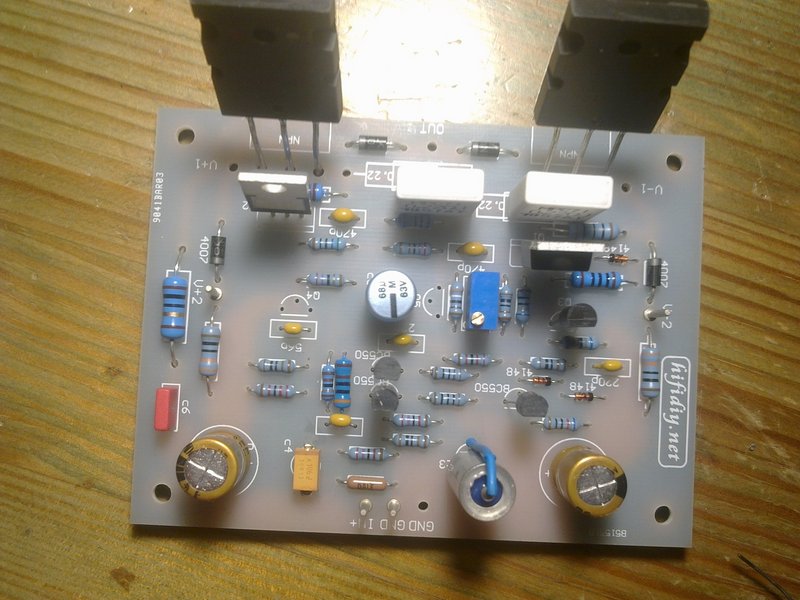
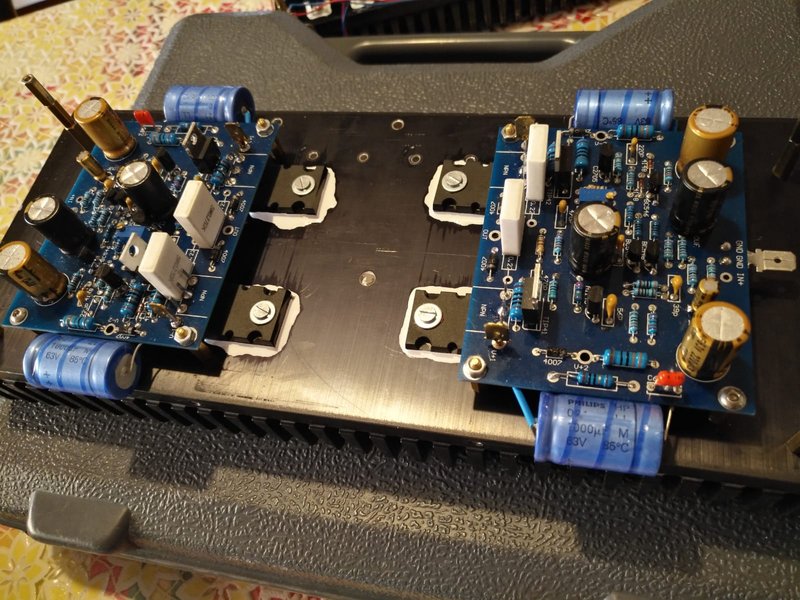
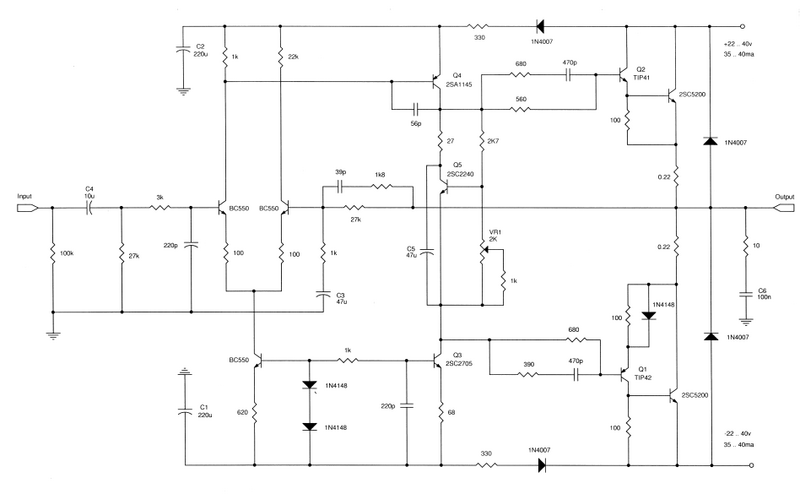
Does anyone know where to buy these boards or something similar?
Thank you.



Last edited:
Yep legion, the first picture is legendary 
I was lucky with transistors when i first got this kit and build it as my first ever amplifier. But this amplifier thermalrunaway after month and a half... and i lost all the outputs, drivers and VAS stage + speakers and could have been lost my house also if i weren't home that day.....
This thing had this "front end" and clear sound signature... it wasn't there always.
It was a good kit... i remember i had pretty high DC offset at the output. It did only work with 2SA1145 and its counterpart, PCB trace lenghts and widths are important.
EDIT: last pick is my first amp... too bad i did not measure anything from that time.
Black PCB's are ordered from china when they were still available and then i copied the design, scanning into a computer and redrawing it exactly as original
But to clarify, original naim(with good pcb, layout design) beats any kit out there, no questions. Does not matter how much filtering u add to the rails or psu, plain naim eats all kits easly
I was lucky with transistors when i first got this kit and build it as my first ever amplifier. But this amplifier thermalrunaway after month and a half... and i lost all the outputs, drivers and VAS stage + speakers and could have been lost my house also if i weren't home that day.....
This thing had this "front end" and clear sound signature... it wasn't there always.
It was a good kit... i remember i had pretty high DC offset at the output. It did only work with 2SA1145 and its counterpart, PCB trace lenghts and widths are important.
EDIT: last pick is my first amp... too bad i did not measure anything from that time.
Black PCB's are ordered from china when they were still available and then i copied the design, scanning into a computer and redrawing it exactly as original
But to clarify, original naim(with good pcb, layout design) beats any kit out there, no questions. Does not matter how much filtering u add to the rails or psu, plain naim eats all kits easly
Attachments
Last edited:
I actually have a lot more "metal cases" prepared for experimenting, one case has a huge glass cover 
All i am into is that finding the real reason, how this two baby's can work together... how to make them benefit from each other.
Is it a delay that is caused by different currents in different sections... how much must be the delay between channels.. or what is the threshold.
Caps and that ESR they have lol....and with temperature as high as it goes...it changes drastically up and down.
+ the burn-in time for every active component, it takes time, about an hour is fine for diodes and transistors @ full power. Then the acoustic result can be listened.
+ oscillations and how to control them and maybe they must be there @ some form..... to make them behave...
There are good quality "breadboards" available... build/breadboard it with small output transistors, measure and listen to it with good quality headphones... make adjustments and make out something of it...then second channel... later on placing them in one case and start measuring and listening all over again... its possible but very time consuming.
Understanding this takes time and effort...for now i will be taking a break
Guys, also, use ventilation or ventilated area for solder jobs if possible.
All i am into is that finding the real reason, how this two baby's can work together... how to make them benefit from each other.
Is it a delay that is caused by different currents in different sections... how much must be the delay between channels.. or what is the threshold.
Caps and that ESR they have lol....and with temperature as high as it goes...it changes drastically up and down.
+ the burn-in time for every active component, it takes time, about an hour is fine for diodes and transistors @ full power. Then the acoustic result can be listened.
+ oscillations and how to control them and maybe they must be there @ some form..... to make them behave...
There are good quality "breadboards" available... build/breadboard it with small output transistors, measure and listen to it with good quality headphones... make adjustments and make out something of it...then second channel... later on placing them in one case and start measuring and listening all over again... its possible but very time consuming.
Understanding this takes time and effort...for now i will be taking a break
Guys, also, use ventilation or ventilated area for solder jobs if possible.
Last edited:
If you want to examine and refine audible differences, you also need to see them. That is, to measure and store or document them for comparison with other circuit or layout arrangements. That is most easily done by simulation and it's how I verified where the nice sounding even harmonic distortion comes from, even though the SPICE models I used at the time, were not correct.
It's all too easy to fool yourself and waste time with fiddling parts on protoboard, breadboard etc. given the delay in time and state of mind between one test and another. If you really want to know something as fact and by proportion rather than subject to your feeling at the moment of testing, you definitely need the help of objective tests.
I'm sure we all start experimenting with "try this - try that" parts swapping but the combinations of all possible changes is daunting and most likely impossible to achieve honestly by any such long series of tests in potentially hundreds of different combinations. If you only want to evaluate the effect of varying a circuit parameter like bias current, it may be simple and better to do tests by ear but the combined effects of component changes demand a more systematic approach, I think.
SPICE is a good, often free and precise tool for audio design. Audio fanatics and newbies who dismiss it as some evil, mechanistic science or imagine that it leads to inhuman, unmusical results are being an ostrich (i.e. head in the sand). What surprised me about me about it's usefulness, was how many assumptions I had based my design mods on, were actually false and how many more solutions existed than basic textbooks suggested. I just hadn't bothered to check them out properly because of the time and expense for reading, obtaining parts and making the changes in order to test them .
.
It's all too easy to fool yourself and waste time with fiddling parts on protoboard, breadboard etc. given the delay in time and state of mind between one test and another. If you really want to know something as fact and by proportion rather than subject to your feeling at the moment of testing, you definitely need the help of objective tests.
I'm sure we all start experimenting with "try this - try that" parts swapping but the combinations of all possible changes is daunting and most likely impossible to achieve honestly by any such long series of tests in potentially hundreds of different combinations. If you only want to evaluate the effect of varying a circuit parameter like bias current, it may be simple and better to do tests by ear but the combined effects of component changes demand a more systematic approach, I think.
SPICE is a good, often free and precise tool for audio design. Audio fanatics and newbies who dismiss it as some evil, mechanistic science or imagine that it leads to inhuman, unmusical results are being an ostrich (i.e. head in the sand). What surprised me about me about it's usefulness, was how many assumptions I had based my design mods on, were actually false and how many more solutions existed than basic textbooks suggested. I just hadn't bothered to check them out properly because of the time and expense for reading, obtaining parts and making the changes in order to test them
try this - try that
I agree that we have to stop this approach(Y)
objective tests and systematic approach
Yes this is what we need. So we can get the "NAP140 clone" as close as possible to the original working conditions.
Basically i will set up some test conditions to catch some differences on oscilloscope and by hearing the circuit.
Yes, i was introduced to TINA-TI and Spice earlier @ job but that just scares me for some reason.... its like: switching from WIN 7 OP. to WIN 10 OP... scary
Yes, PC nightmares  Try that comparison with WIN 8 and 8.1 between WIN 7 and WIN 10 and you'll know what really scary means. Eventually your operating system becomes a nightmare of constant updates, internet security failures and software conflicts, unwanted advertisements everywhere, you name it. I guess like mobile phone brands, Microsoft try too hard and too often to keep adding new bling and features in attempts to displace your personal preferences.
Try that comparison with WIN 8 and 8.1 between WIN 7 and WIN 10 and you'll know what really scary means. Eventually your operating system becomes a nightmare of constant updates, internet security failures and software conflicts, unwanted advertisements everywhere, you name it. I guess like mobile phone brands, Microsoft try too hard and too often to keep adding new bling and features in attempts to displace your personal preferences.
The premium free SPICE simulation tool for audio is the one you mostly see here; LT SPICE and it's available at LTspice | Design Center | Analog Devices but it takes time to understand and use the GUI and manual settings regime for run times, installing parts models and its many other controls. TINA is much simpler and I find it quick to use for the basic design but unfortunately, it doesn't have a graphical display of harmonic distortion so it doesn't really do much more than prove the fundamental performance of the amplifier.
The premium free SPICE simulation tool for audio is the one you mostly see here; LT SPICE and it's available at LTspice | Design Center | Analog Devices but it takes time to understand and use the GUI and manual settings regime for run times, installing parts models and its many other controls. TINA is much simpler and I find it quick to use for the basic design but unfortunately, it doesn't have a graphical display of harmonic distortion so it doesn't really do much more than prove the fundamental performance of the amplifier.
<snip>
The premium free SPICE simulation tool for audio is the one you mostly see here; LT SPICE and it's available at LTspice | Design Center | Analog Devices but it takes time to understand and use the GUI and manual settings regime for run times, installing parts models and its many other controls. TINA is much simpler and I find it quick to use for the basic design but unfortunately, it doesn't have a graphical display of harmonic distortion so it doesn't really do much more than prove the fundamental performance of the amplifier.
I've used TINA since around 2003 or so, and I've tried several other spice software packages but always go back to TINA - as you say, it's very easy to use.
Regarding a distortion graph - I can get an FFT graph, is this what you mean?
Attachments
- Home
- Amplifiers
- Solid State
- NAP-140 Clone Amp Kit on eBay
